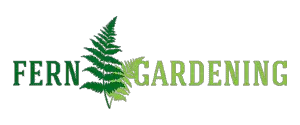One of the best ways to highlight ferns is to plant them in a hanging basket or pot. Many varieties of ferns grow as a burst of green foliage, forming a bush so lush that the fronds spill over the sides of the planter. Raising this display up to eye level where it can be properly admired really is one of the best ways of showcasing their beauty.
Many ferns work well in a hanging basket or pot, but the best all round choice is the Nephrolepis species, including the classic Boston and Kimberley Queen ferns. Other attractive options are the maidenhair, kangaroo and staghorn ferns, but really any variety that grows abundant foliage with a trailing habit can work well.
Here are twelve of the best ferns for hanging, along with some tips on how to set up the basket or pot in a way that ensures you will get the best growth and impact.
What to look for in a good hanging fern
There are a few key features that are essential for getting good results from ferns planted in a hanging basket or pot. First, you need a variety that has abundant foliage, which forms a striking bushy crown that overwhelms and conceals the basket. As well as abundance, though, you need to consider the growth habit of the plant, and look for varieties that have trailing, hanging fronds.

More upright-growing varieties can still work, but will have to be hung lower to avoid the view being dominated by the underside of the fronds. If the pot will be visible, you can of course choose a decorative design, but most people prefer to show off the plant rather than the vessel.
It can also useful to choose ferns that are relatively fast growing, so that they fill out quickly if you start with a smaller specimen (which is more affordable). Another factor is whether the fern can tolerate occasional periods of dryness. Hanging baskets can drain quickly, and – let’s be honest – are not the easiest to water. That combination means they can sometimes be forgotten for a few days, making them a unreliable option for ferns that are very sensitive to changes in soil moisture.
Best ferns for indoor baskets
Tropical varieties of fern make for excellent indoor hanging baskets, and of these the Nephrolepis species ferns are the undoubted stars.
The Boston fern is what many people first think of when they imagine a fern, and that reputation is well deserved.
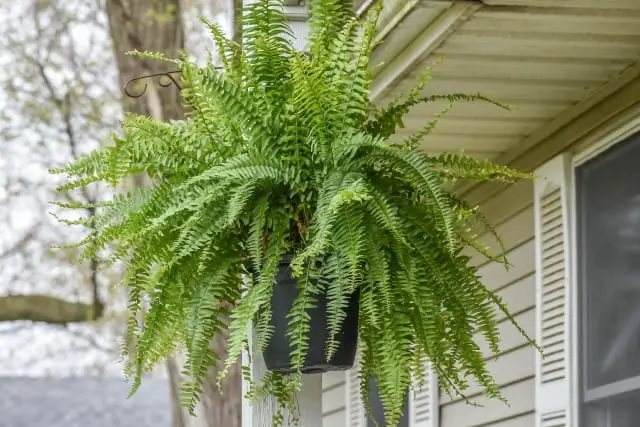
Boston fern
- Nephrolepis exaltata
- Evergreen
- Partial shade
- Height: up to 1 m
- Soil: acid or neutral. Moist, well-drained.
Another excellent choice – perhaps the best of the Nephrolepis ferns – is a variegated cultivar of the Boston fern: the Tiger fern. Long, trailing, beautiful fronds make the Tiger fern tailor-made for hanging.
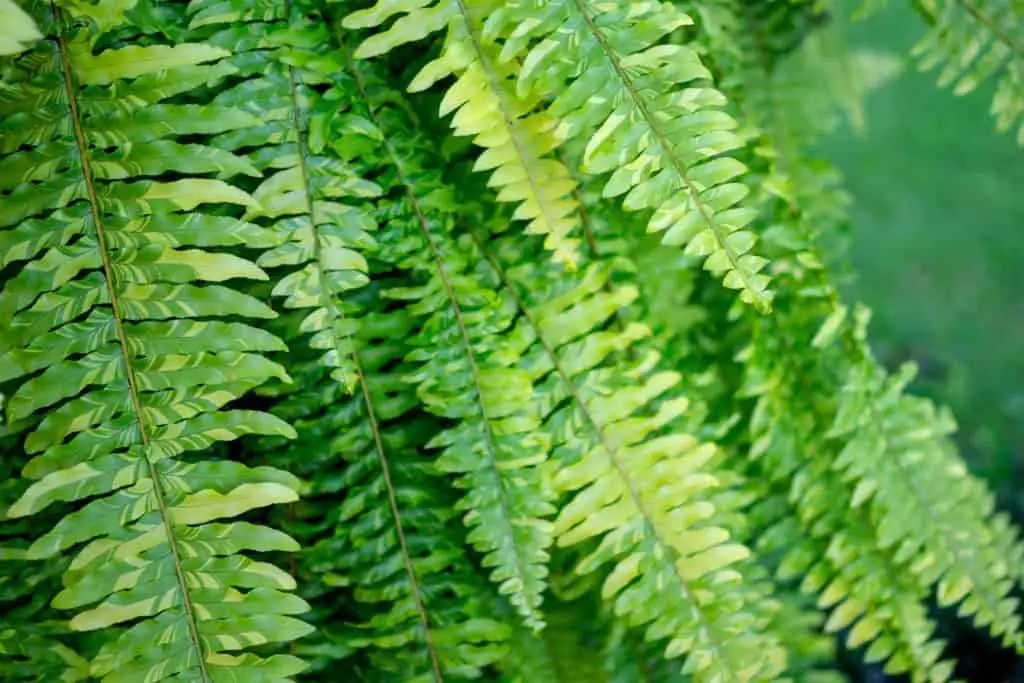
Another popular hanging variety is the Kimberley queen fern (Nephrolepis obliterata). It is similar in appearance to the classic Boston, but more tolerant of sun, giving more options for locating it around the home.
An additional member of the Nephrolepis family has a rather different style – a more robust, glossy, dark green and domineering form – the Macho fern.
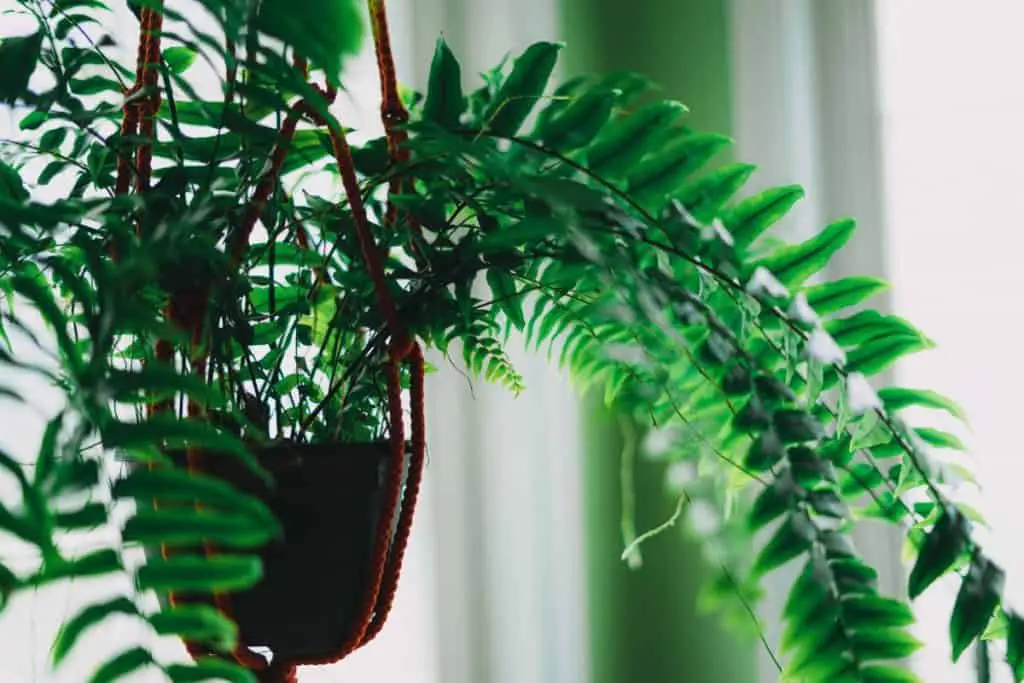
Macho fern
- Nephrolepis biserrata
- Evergreen
- Partial or full shade
- Height: up to 2 m
- Soil: acid or neutral. Moist, well-drained
As the name suggests, Macho ferns can grow to be enormous. If you are looking to make a lot of impact with a grand statement, Macho ferns are a great choice.
Moving on from Nephrolepis, another option to make a bold statement is the Kangaroo paw fern. Like the Macho fern, this variety has lush, broad, large fronds, and grows as a cavalcade of foliage that dominates the space it occupies. It is well suited for baskets, with long, downward trailing fronds.
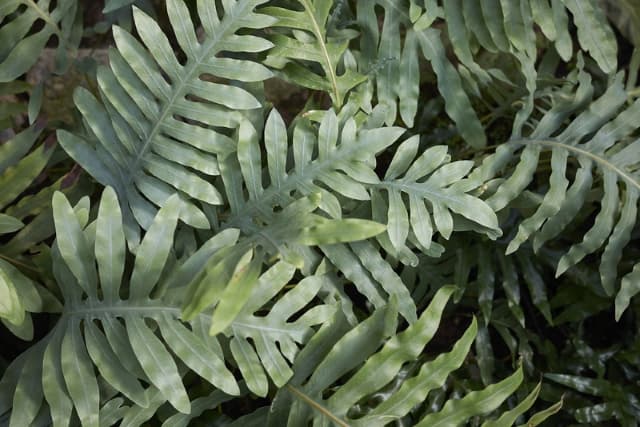
Kangaroo paw fern
- Microsorum diversifolium
- Evergreen
- Prefers partial shade
- Height: up to 0.5 m
- Soil: acid or neutral. Moist, well-drained.
At the other end of the style spectrum, the Maidenhair fern is prized for its delicate foliage. The sprays of small, round leaflets of the Maidenhair are more like a diffuse cloud than the trailing chains of fronds of most ferns.
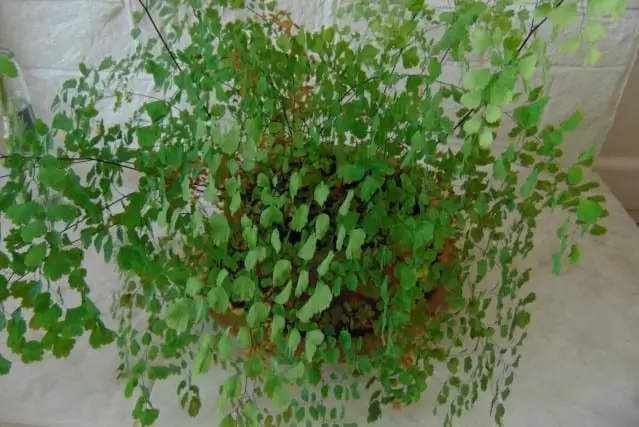
Maidenhair fern
- Adiantum raddianum
- Evergreen
- Partial shade
- Height: up to 0.5 m
- Soil: neutral or alkaline. Moist, well-drained.
Another choice for a more subtle impact is the Rabbit’s foot fern, or related Davallia species. Although famed for their characteristic hairy rhizomes (which can make an interesting sight tangled around the edges of a basket), the fine, divided fronds also hang low, creating a curtain of delicate beauty.
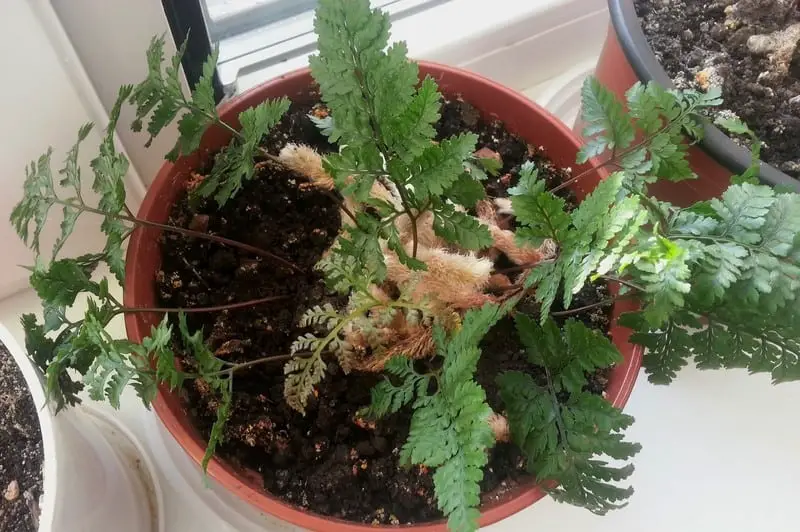
Rabbit’s foot fern
- Davallia solida (var. fejeensis)
- Evergreen
- Partial shade
- Height: up to 1 m
- Soil: acid or neutral. Moist, well-drained.
Finally, for a more unusual impact, there is the Staghorn fern. This otherwordly variety can be trained into a hanging basket, as well as its more traditional mounting directly onto a plate or board. A cluster of Staghorns planted close together makes for a real talking point.
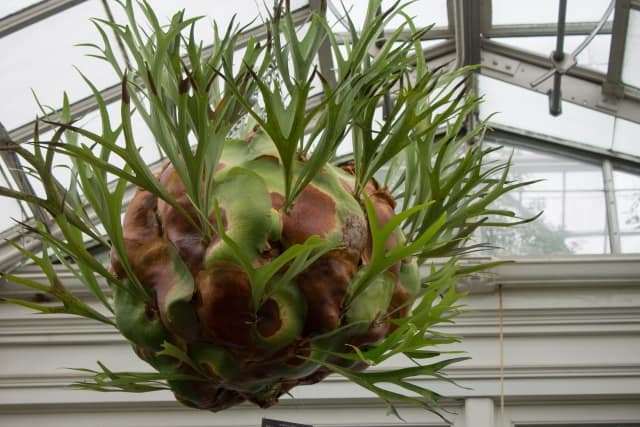
Staghorn fern
- Platycerium bifurcatum
- Evergreen
- Prefers partial shade
- Height: up to 1 m
- Epiphytic (but can be grown on loam). Keep moist, well-drained.
Best ferns for outdoor baskets
All of the tropical varieties of ferns that suitable for indoor planting can also be grown successfully outside during the warmer parts of the year, and many people decorate their summer porches and balconies with hanging ferns. These varieties are unlikely to survive the winter in most hardiness zones, though, and so if you want to keep your baskets outdoors for a longer stretch of the year, it is worth considering some more cold-hardy ferns.
Starting with a hardy sword fern that resembles the Boston and Kimberley Queen for foliage, the Christmas fern is a reliable choice that is more robust through the colder seasons of the year. Prized for winter decoration, it also works well in a hanging basket as a hardy alternative to the Nephrolepis species – although the fronds do not trail to the same extent.
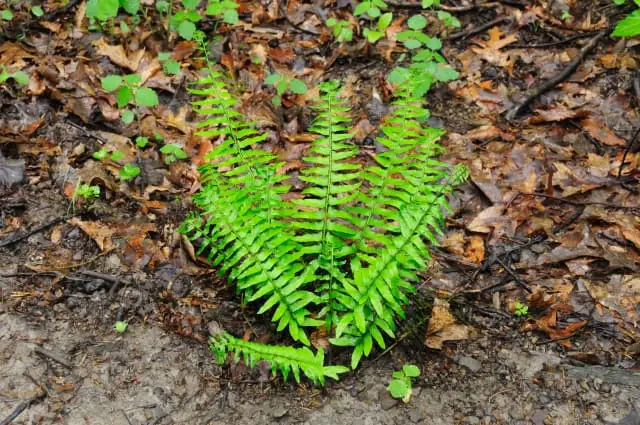
Christmas fern
- Polystichum acrostichoides
- Evergreen
- Partial shade
- Height: up to 1 m
- Soil: acid, neutral or alkaline. Moist, well-drained.
The Soft shield fern is another good choice for outdoor hanging. Although more commonly planted in the ground, the fronds are so light and fine that they droop and trail when planted in a hanging basket or raised planter.
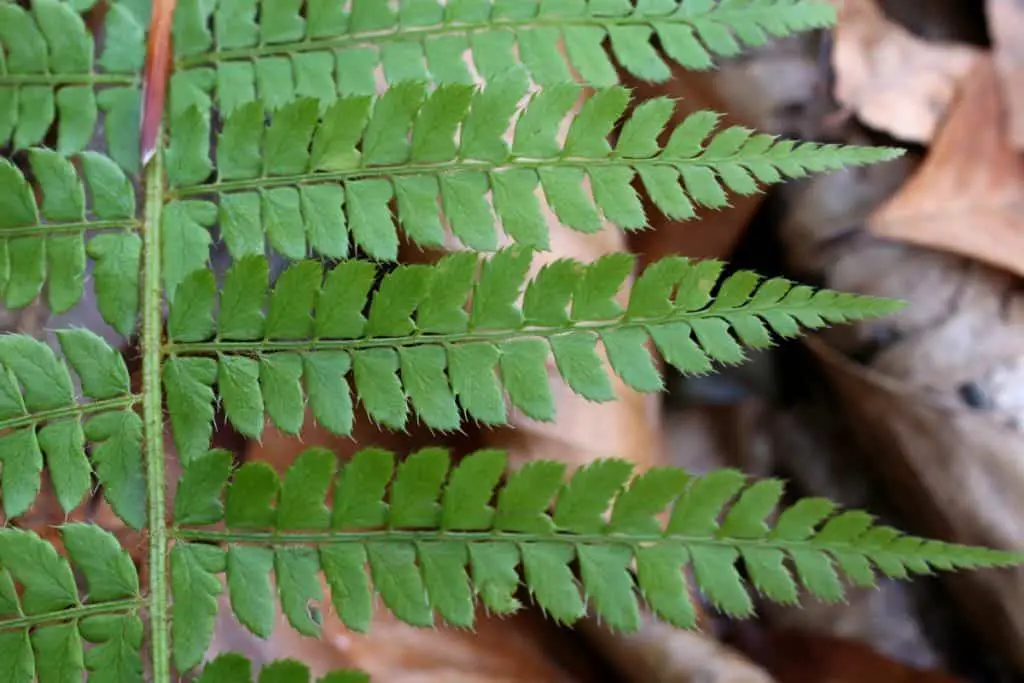
Soft Shield fern
- Polystichum setiferum
- Evergreen
- Full or partial shade
- Height: 0.5 – 1 m
- Soil: Acid, neutral or alkaline. Moist, well-drained.
Similarly, the delicate foliage of the Lady fern is also well suited to life in a basket. The many cultivars and varieties of the parent plant may be too small or upright to work well, but the original and best is a promising option with long pendulous fronds that drape low.
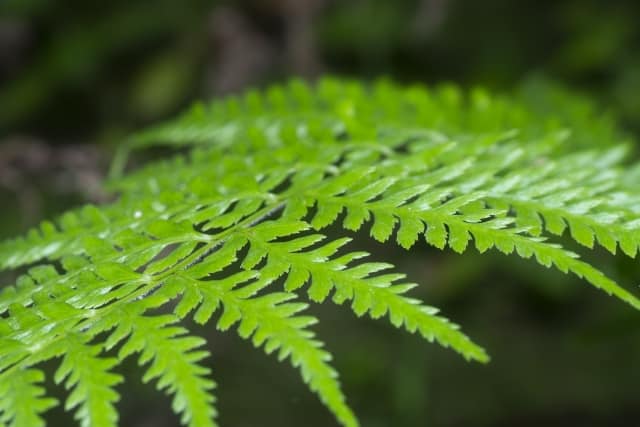
Lady fern
- Athyrium filix-femina
- Deciduous
- Prefers partial or full shade
- Height: up to 1 m
- Soil: acid or neutral. Moist, poor drainage tolerated.
Another good choice is a cultivar of Dryopteris affinis known as ‘Cristata the king’. Although only semi-evergreen in colder climates, it has such interesting ruffled edges and bifurcated frond tips that its curly, crinkled foliage provides an eye-catching shower of green that it works well in baskets or urns.
Finally, it is worth mentioning a slightly unusual option. Hay scented fern is invasive in the open ground, but it can work well if constrained within a hanging basket or pot.

Hay-scented fern
- Dennstaedtia punctilobula
- Deciduous
- Full or partial shade
- Height: up to 1 m
- Soil: acid or neutral. Moist, well-drained, and tolerates dry soil.
One particular benefit of the Hay-scented fern (aside from the scent) is that is tolerates periods of drought, and so is forgiving of forgetful gardeners.
How to set up hanging pots and baskets for ferns
When ferns are first bought from nurseries and garden centers they often come in plastic hanging pots (the classic type having a heavy-duty plastic hook in the center). While these can work, they aren’t very appealing as a design.
For indoor planting, the best way to set up a fern for hanging is to simply plant in a pot as usual and then hang this using a decorative strap or cage. This makes life easy, as you can choose the best potting mix, and location to suit the fern you want.
Many people also make a feature of the hanger itself – using macramé weaves or copper wire for example to add a design note to the feature.

Ferns need moist but well-drained soil, and so it is important that the pot is contained in some way to prevent drips ruining furniture or upholstery. A common method is double-potting, where the fern is planted in a plastic pot that drains, but this is nestled within a more attractive ceramic outer pot.
Alternatively, there are specialist hanging pots with built in trays or “cachepots” that retain any excess water. By using straps to hang a self-watering pot, you can protect against forgetfulness too.
Outdoors, preparation is even simpler. You don’t need to worry so much about drainage making a mess, and so the classic coir-lined hanging basket is a great choice. The only real additional concern is the frequency of watering needed to prevent the roots drying out. It can be worth supplementing the potting mix with more moisture-retaining humus and vermiculite to aid retention. Similarly, although ferns generally do not need feeding, it can be worth adding monthly fertilizer (at 50% of recommended strength) during the growing season to replenish and nutrients that may have been washed away.
Finally, although we have covered some of the best varieties for hanging ferns on their own, it is also possible to combine different ferns within one hanging pot or basket. This can be especially effective if an upright variety like a Bird’s nest fern is combined with a trailing variety like Boston fern. The combination can be even more attractive than the individual plants alone.
Many varieties of ferns work well in hanging planters. It’s a great way to display the lush, cascading foliage of the Nephrolepis species, but that is only the start of the potential that ferns can offer.
